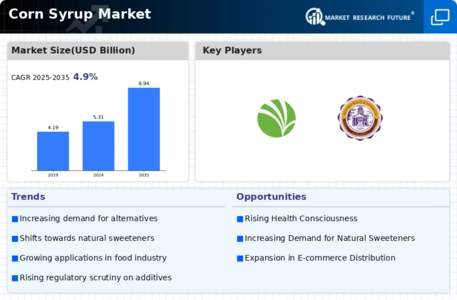Rising Demand for Sweeteners
The Corn Syrup Market experiences a notable increase in demand for sweeteners, driven by changing consumer preferences. As consumers seek alternatives to traditional sugar, corn syrup emerges as a viable option due to its cost-effectiveness and versatility. In recent years, the market for corn syrup has expanded, with a reported growth rate of approximately 3.5% annually. This trend is likely to continue as manufacturers increasingly incorporate corn syrup into various food products, including beverages and baked goods. The ability of corn syrup to enhance flavor and texture further solidifies its position in the market. Consequently, the rising demand for sweeteners significantly influences the Corn Syrup Market, prompting producers to innovate and adapt their offerings to meet consumer expectations.
Innovations in Food Technology
Innovations in food technology are transforming the Corn Syrup Market, as advancements in production processes lead to improved quality and efficiency. The introduction of new extraction and refining techniques has enabled manufacturers to produce corn syrup with enhanced purity and functionality. These technological advancements not only improve the overall quality of corn syrup but also expand its applications in various food products. For instance, the development of enzyme technology has allowed for the creation of specialized corn syrups tailored for specific uses, such as low-calorie or high-fructose variants. As food technology continues to evolve, the Corn Syrup Market is likely to benefit from these innovations, fostering growth and diversification in product offerings.
Cost-Effectiveness of Corn Syrup
The cost-effectiveness of corn syrup plays a pivotal role in shaping the Corn Syrup Market. Compared to other sweeteners, corn syrup is often less expensive to produce, making it an attractive option for food manufacturers. This economic advantage is particularly relevant in a market where price sensitivity is prevalent among consumers. Recent analyses indicate that corn syrup can be produced at a lower cost per unit than cane sugar or high-fructose corn syrup, which enhances its appeal in various applications. As food manufacturers strive to maintain profitability while meeting consumer demands, the cost-effectiveness of corn syrup becomes a significant factor in their ingredient choices. Thus, the economic benefits associated with corn syrup are likely to continue driving its adoption within the Corn Syrup Market.
Expansion of the Food and Beverage Sector
The Corn Syrup Market benefits from the ongoing expansion of the food and beverage sector. As the global population continues to grow, the demand for processed foods and beverages rises correspondingly. This trend is particularly evident in regions where urbanization is accelerating, leading to increased consumption of convenience foods. According to recent data, the food and beverage sector is projected to grow at a compound annual growth rate of 4.2% over the next five years. This growth directly impacts the corn syrup market, as manufacturers seek to enhance product formulations with corn syrup to improve sweetness and texture. The expansion of this sector thus serves as a critical driver for the Corn Syrup Market, creating opportunities for producers to expand their market reach and innovate their product lines.
Regulatory Environment and Labeling Trends
The regulatory environment and labeling trends significantly impact the Corn Syrup Market. As consumers become more health-conscious, there is an increasing demand for transparency in food labeling. Regulatory bodies are responding by implementing stricter guidelines regarding the labeling of sweeteners, including corn syrup. This shift may lead to changes in how corn syrup is marketed and perceived by consumers. For instance, products containing corn syrup may require clearer labeling to indicate their nutritional content. Consequently, manufacturers in the Corn Syrup Market must adapt to these evolving regulations and consumer expectations, potentially leading to reformulations or new product developments that align with health trends. This dynamic regulatory landscape presents both challenges and opportunities for stakeholders within the industry.


















Leave a Comment